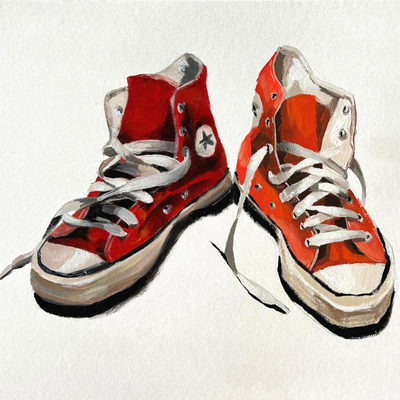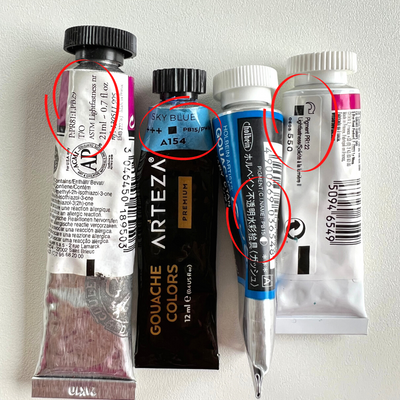The Ultimate Gouache Paint FAQ for Artists
Are you new to gouache paint and wondering how to get started? Or maybe you’re an experienced artist looking to expand your knowledge of this versatile medium? This FAQ will cover everything you need to know about gouache paint.
Table of Contents
- What is gouache paint?
- How is gouache paint different from watercolor?
- How is gouache paint different from acrylic?
- How is gouache paint different from oil paint?
- What surfaces can I use gouache paint on?
- How do I mix gouache paint?
- How do I store gouache tubes?
- How do I store gouache paint?
- Can gouache paint be used for professional art?
- Can gouache paint be used in combination with other mediums?
- What is the best way to apply gouache paint?
- How do I thin gouache paint?
- How do I clean gouache paint from my brushes and other tools?
- How do I protect my gouache paint artwork?
- How do I fix mistakes when using gouache paint?
- How many layers of gouache can you apply?
- Can you make your gouache paint?
- What brushes to use for gouache?
- Can you mix gouache with acrylic?
- Can you use gouache over watercolor?
- Why is my gouache not opaque?
- How long does a tube of gouache last?
- Does gouache paint smell?
What is gouache paint?
Gouache paint is a water-based paint made with pigment, gum arabic, and a binding agent. It has a creamy consistency and is known for its ability to create vibrant, opaque colors.
How is gouache paint different from watercolor?
Gouache paint is similar to watercolor paint because it is water-based and can be thinned with water. However, it is different because it is more opaque, meaning it can completely cover the surface when applied.
How is gouache paint different from acrylic?
Gouache and acrylic paints are both water-based paints with different characteristics and properties. Gouache paint is more opaque, has a creamy consistency, and dries quickly with a matte finish. In contrast, acrylic paint is more transparent, has a thicker consistency, and dries slowly with a glossy finish. Painters can use both paints for various artistic applications, but their choice will depend on the desired effect and surface.
How is gouache paint different from oil paint?
Gouache and oil paint are two different mediums with distinct characteristics and properties. Gouache is a water-based paint made with pigment, gum arabic, and a binding agent, while oil paint is pigment suspended in a drying oil, such as linseed oil. Gouache paint is more opaque and has a matte finish when dry, while oil paint is more transparent and glossy. Gouache dries more quickly than oil paint, which allows the artist to work more rapidly, but oil paint has a longer drying time, which allows the artist more time to work with it.

What surfaces can I use gouache paint on?
You can apply gouache on various surfaces, including paper, canvas, wood, and cardboard. It is a versatile medium well-suited for different projects and techniques.
How do I mix gouache paint?
To mix gouache paint, you will need a palette or mixing tray, water, and a brush. Start by adding a small amount of water to your palette, and then add a small amount of paint to the water. Mix the paint and water with your brush until you have achieved the desired consistency. You can continue to add more paint or water as needed to achieve the desired color and thickness.
How do I store gouache tubes?
When you have a lot of tubes, you will need a system to store them so they are protected and sorted by color. Different options are available, from recycling jars, using Ziploc bags, or buying drawers. All the different options, DIY or commercial, are discussed here.
How do I store gouache paint?
You should store gouache in a cool, dry place away from direct sunlight. It is best to keep the paint in its original container, with the lid securely fastened to prevent it from drying out. If you are working with a large quantity of paint, transfer a small amount to a palette or mixing tray for use and then store the remainder in its original container. You can also keep your gouache paint in airtight palettes to preserve its freshness.
Can gouache paint be used for professional art?
Gouache paint is a popular medium among professional artists in many applications, including illustration, graphic design, and fine art. Artists have used gouache for thousands of years. Its ability to create vibrant, opaque colors and its versatility makes it a favorite among many professional artists.

Can gouache paint be used in combination with other mediums?
You can combine gouache with other mediums, such as colored pencils, markers, or ink. It can also be layered over other mediums, such as watercolors, to create a more opaque effect.
What is the best way to apply gouache paint?
Gouache paint can be applied using various tools, including brushes, sponges, and palette knives. It is a versatile medium that can be applied in thin layers or thick, textured strokes, depending on the desired effect.
How do I thin gouache paint?
Use water to thin gouache, add a small amount to the paint, and mix it until you have completed the desired consistency. Remember that the more water you add, the more transparent the paint will become.
How do I clean gouache paint from my brushes and other tools?
Soap and tap water are enough to remove gouache from brushes and other tools. Wet the brush or tool and apply a small amount of soap to the bristles or surface. Gently scrub the brush or tool to remove the paint, and then rinse it thoroughly with water. Repeat the process as needed until all of the paint has been removed. You can even clean dry paint on palettes weeks after, let it soak for a while, and rub it gently with tap water.

How do I protect my gouache paint artwork?
You can protect your gouache artwork with a varnish spray, which will help to preserve the colors and prevent the paint from smudging or fading. It is a good idea to apply the fixative in a well-ventilated area and to follow the manufacturer’s instructions for application. You can also frame your gouache paint artwork under glass to provide additional protection.
How do I fix mistakes when using gouache paint?
Gouache paint is relatively easy to work with, and mistakes can often be corrected by simply painting over the area with a new layer of paint. If the paint has already dried, you may need to re-wet the area and then carefully remove the paint with a brush or sponge before applying a new layer.
How many layers of gouache can you apply?
There is no specific limit to the number of layers of gouache paint you can apply. However, 5 or 6 layers seem to be the maximum that paper can handle. Gouache paint is a relatively opaque medium, so it is possible to build up multiple layers to achieve the desired level of coverage and depth. However, it is important to allow each layer to dry completely before applying the next and to avoid using too much paint at once, as this can result in a thick, heavy layer that is difficult to work with and may take a long time to dry. As a general rule, it is best to build up your layers gradually, applying thin layers and allowing them to dry before adding more, increasing the consistency of each layer.

Can you make your gouache paint?
It is possible to make your gouache paint at home, although purchasing pre-made gouache paint from an art supply store is generally easier. To make your gouache paint, you will need pigments, gum arabic, and a binding agent. Remember that making your gouache paint can be time-consuming and require experimentation to achieve the desired results. It may be more convenient to purchase pre-made gouache paint, especially if you are new to working with this medium.
What brushes to use for gouache?
Gouache paint can be applied using a variety of brushes, including natural bristle brushes, synthetic bristle brushes, and even foam brushes. The type of brush you choose will depend on the desired effect and the surface you are working on. It is a good idea to experiment with different brushes to find the ones that work best for you and your project.
Can you mix gouache with acrylic?
It is generally not recommended to mix gouache paint with acrylic paint, as the two mediums have different properties and may need to work better together. Combining the two paints may result in the paint with properties between gouache and acrylic. Still, it is unlikely to produce optimal paint for any specific application. If you want to use gouache and acrylic paints in a single project, use them separately rather than trying to mix them.
Can you use gouache over watercolor?
You can apply gouache over watercolor to create a more opaque effect. Gouache paint is more opaque than watercolor and is less transparent, so you can cover up or modify areas of a watercolor painting with gouache. To use gouache over watercolor, apply the gouache paint over the dry watercolor layer, using a brush or other tool to apply the paint. Be sure to apply it in thin layers to avoid obscuring the watercolor.
Why is my gouache not opaque?
Gouache paint can become less opaque because the paint has dried or is thinned too much with water. To fix these issues, use only fresh creamy paint from the tube, and add a tiny amount of water. Experiment with different techniques and adjustments until you achieve the desired opacity level. Often times, opacity and consistency are related.

How long does a tube of gouache last?
The shelf life of a tube of gouache paint depends on several factors, including the brand, the color, the quality, the amount of paint used, and the storage conditions. Gouache paint is water-based and will dry out if left uncovered for an extended period, so it is important to keep the paint sealed and stored in a cool, dry place to extend its shelf life. Properly stored gouache paint can last for several years, although the quality of the paint may degrade over time, especially if it has been opened and exposed to air.
Does gouache paint smell?
Gouache paint is water-based and does not have a strong smell. Some people may notice a slight paint-like odor when working with gouache, but it is generally not as strong or overpowering as the smell of oil paint or other types of solvent-based paints. Gouache paint is a safe, non-toxic medium that is suitable for people of all ages and is a good choice for artists who are sensitive to strong odors or concerned about the health and safety implications of using certain types of paints.






